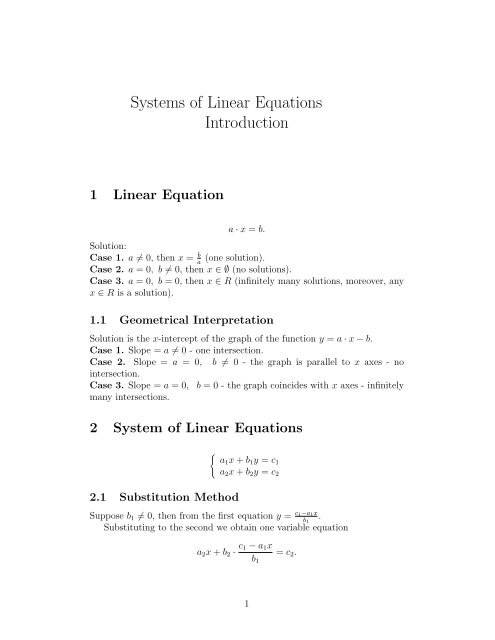Systems of Linear Equations Introduction
Systems of Linear Equations Introduction
Systems of Linear Equations Introduction
Create successful ePaper yourself
Turn your PDF publications into a flip-book with our unique Google optimized e-Paper software.
Another way: suppose we have a matrix already in row echelon form.Then first convert each pivot a to 1 multiplying its row by 1 , then use theseapivots (starting with the 1 in the last row) to kill all the entries above it.3.2.1 Example <strong>of</strong> a system with one solution.Consider the system⎧⎪⎨⎪⎩2x + y − z = 8−3x − y + 2z = −11−2x + y + 2z = −3The augmented matrix <strong>of</strong> this system is⎛⎜⎝2 1 −1 8−3 −1 2 −11−2 1 2 −3⎞⎟⎠ .The Gauss elimination algorithm gives⎛⎜⎝⎛⎜⎝2 1 −1 8−3 −1 2 −11−2 1 2 −3⎛⎜⎝⇓ 3 2 · I + II2 1 −1 8102112−2 1 2 −3⇓ I + III2 1 −1 80 1 21120 2 −1 5⎞⎞⎟⎠ .⎞⎟⎠⎟⎠ .⇓ −4 · II + III⎛⎞2 1 −1 8⎜⎝ 0 1 1 ⎟12 2 ⎠ .0 0 −1 1This is the row echelon form.So our system is equivalent to the following system⎧⎪⎨⎪⎩2x + y − z = 812 · y + 1 2 · z = 1−z = 16
and x, y, z can be found by back substitution:x = 2, y = 3, z = −1.The Gauss-Jordan elimination algorithm gives the reduced row echelonform⎛⎞1 0 0 2⎜⎟⎝ 0 1 0 3 ⎠ .0 0 1 −1So the solution is the last columnx = 2, y = 3, z = −1.3.2.2 Example <strong>of</strong> a system with many solutions.Consider the system⎧⎪⎨⎪⎩x + 2y + 0 · z + 3t = 52x + 3y + 2z + 5t = 40 · x + 2y + z + 5t = 2The augmented matrix <strong>of</strong> this system is⎛⎜⎝1 2 0 3 5−2 3 2 5 40 2 1 5 2⎞⎟⎠ .The Gauss elimination algorithm gives the following row echelon form⎛⎜⎝Corresponding system looks as⎧⎪⎨⎪⎩1 2 0 3 50 −1 2 −1 −60 0 5 3 −10⎞⎟⎠ .x + 2y + 0 · z + 3t = 5−y + 2z − t = −65z + 3t = −10Take free variable t. Then the back substitution givesz = − 3 5 t − 2, y = −11 5 t + 2, x = 7 5 t + 1.7
4.2 Two-commodity market equilibriumQ d1 demand <strong>of</strong> commodity 1; Q s1 supply <strong>of</strong> commodity 1;Q d2 demand <strong>of</strong> commodity 2, Q s2 supply <strong>of</strong> commodity 2;P 1 price per unit <strong>of</strong> commodity 1; P 2 price per unit <strong>of</strong> commodity 2.Demand function for commodity 1:Demand function for commodity 2:Supply function for commodity 1:Supply function for commodity 2:Q d1 (P 1 , P 2 ) = a 0 + a 1 P 1 + a 2 P 2 .Q d2 (P 1 , P 2 ) = α 0 + α 1 P 1 + α 2 P 2 .Q s1 (P 1 , P 2 ) = b 0 + b 1 P 1 + b 2 P 2 .Q s2 (P 1 , P 2 ) = β 0 + β 1 P 1 + β 2 P 2 .Equilibrium conditions Q d1 = Q s1 , Q d2 = Q s2 :{a0 + a 1 P 1 + a 2 P 2 = b 0 + b 1 P 1 + b 2 P 2α 0 + α 1 P 1 + α 2 P 2 = β 0 + β 1 P 1 + β 2 P 2∣ ∣∣∣∣⇒{(a1 − b 1 ) · P 1 + (a 2 − b 2 ) · P 2 = b 0 − a 0(α 1 − β 1 ) · P 1 + (α 2 − β 2 ) · P 2 = β 0 − α 0∣ ∣∣∣∣.Equilibrium prices P 1 and P 2 can be solved from this system.4.3 Equilibrium in National IncomeI investment, G spending by government, a autonomous consumption, bmarginal propensity to consumption, Y National Income, C consumption.Equilibrium condition{Y = C + I + GC = a + bY∣Y − C = I + GbY − C = −a∣Y = I+G+a1−bC = a+b·(I+G)1−b.9
ExercisesSolve these systems using all 3 methods (Gauss, Gauss-Jordan, determinant),and give the suitable graphical interpretation for1.{2x − y = 5x + y = 42.{2x − y = 54x − 2y = 4 3. {2x − y = 54x − 2y = 102. Give examples <strong>of</strong> systems 2 × 2 and 3 × 3 with (a) one solution, (b) nosolutions, (c) infinitely many solutions.{2x + ky = 83. Find the values <strong>of</strong> k and c for which the systemis (a)4x + 8y = cconsistent (i.e. it has solutions), (b) inconsistent (i.e. it has no solutions).Exercises 7.1-7.3, 7.7-7.18 from SB.10
















